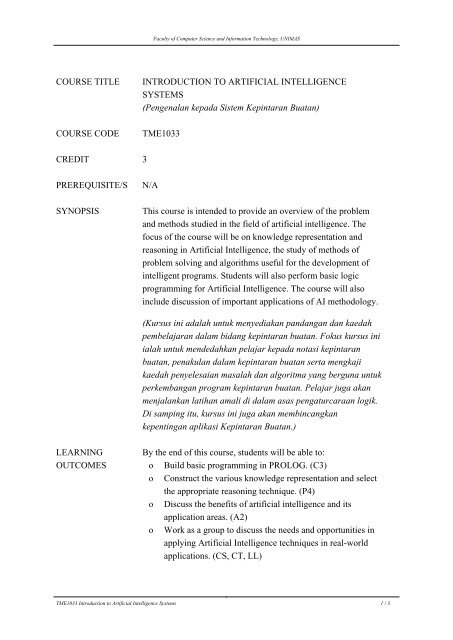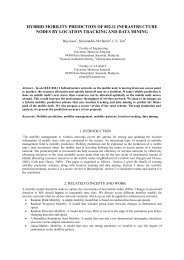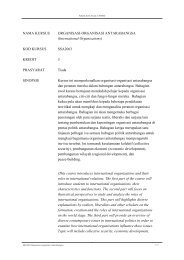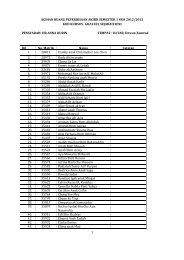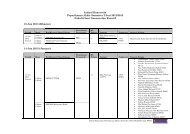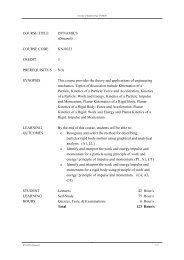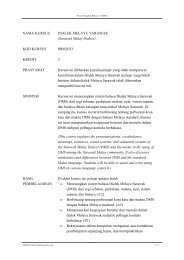COURSE TITLE INTRODUCTION TO ARTIFICIAL INTELLIGENCE ...
COURSE TITLE INTRODUCTION TO ARTIFICIAL INTELLIGENCE ...
COURSE TITLE INTRODUCTION TO ARTIFICIAL INTELLIGENCE ...
You also want an ePaper? Increase the reach of your titles
YUMPU automatically turns print PDFs into web optimized ePapers that Google loves.
Faculty of Computer Science and Information Technology, UNIMAS<strong>COURSE</strong> <strong>TITLE</strong><strong>COURSE</strong> CODE<strong>INTRODUCTION</strong> <strong>TO</strong> <strong>ARTIFICIAL</strong> <strong>INTELLIGENCE</strong>SYSTEMS(Pengenalan kepada Sistem Kepintaran Buatan)TME1033CREDIT 3PREREQUISITE/SSYNOPSISN/AThis course is intended to provide an overview of the problemand methods studied in the field of artificial intelligence. Thefocus of the course will be on knowledge representation andreasoning in Artificial Intelligence, the study of methods ofproblem solving and algorithms useful for the development ofintelligent programs. Students will also perform basic logicprogramming for Artificial Intelligence. The course will alsoinclude discussion of important applications of AI methodology.(Kursus ini adalah untuk menyediakan pandangan dan kaedahpembelajaran dalam bidang kepintaran buatan. Fokus kursus iniialah untuk mendedahkan pelajar kepada notasi kepintaranbuatan, penakulan dalam kepintaran buatan serta mengkajikaedah penyelesaian masalah dan algoritma yang berguna untukperkembangan program kepintaran buatan. Pelajar juga akanmenjalankan latihan amali di dalam asas pengaturcaraan logik.Di samping itu, kursus ini juga akan membincangkankepentingan aplikasi Kepintaran Buatan.)LEARNINGOUTCOMESBy the end of this course, students will be able to:o Build basic programming in PROLOG. (C3)o Construct the various knowledge representation and selectthe appropriate reasoning technique. (P4)o Discuss the benefits of artificial intelligence and itsapplication areas. (A2)o Work as a group to discuss the needs and opportunities inapplying Artificial Intelligence techniques in real-worldapplications. (CS, CT, LL)TME1033 Introduction to Artificial Intelligence Systems 1 / 3
Faculty of Computer Science and Information Technology, UNIMASSTUDENTLEARNINGHOURSLecturesTutorialsStudent-Centered LearningSelf-StudyQuizzes, Tests, & ExaminationsTotal28 Hour/s14 Hour/s4 Hour/s68 Hour/s6 Hour/s120 Hour/sLEARNINGUNITSSupervisedLearning Hours1. Introduction- What is Artificial Intelligence- The Foundations of Artificial Intelligence- The History of Artificial Intelligence32. Intelligent Agents- Introduction- How Agents Should Act- Structure of Intelligent Agents- Environments33. Knowledge Representation- Knowledge- Knowledge Category- Knowledge Hierarchy- Knowledge Representation- Principles- Methodology44. Reasoning- Reasoning Definition- Type of Reasoning- Inference Strategies- Control Strategies45. Rule-based expert system- Rules as a knowledge representation technique- Main players in the expert system developmentteam- Structure of a rule-based expert system- Fundamental characterics of an expert system- Advantages nad disadvantages of a rule-based4TME1033 Introduction to Artificial Intelligence Systems 2 / 3
Faculty of Computer Science and Information Technology, UNIMASexpert system6. AI programming4- Introduction- Programming (LISP, PROLOG)7. Artificial Intelligent Applications (1)- Machine Learning- Neural Network- Natural Language Understanding38. Artificial Intelligent Applications (2)3- Genetic Algorithms- Fuzzy LogicASSESSMENT Assignment 110 %Assignment 210 %Project20 %Mid Term Exam20 %Final Exam40 %Total100 %REFERENCES 1. Artificial Intelligence: A Guide to Intelligent Systems byMichael Negnevitsky, Addison Wesley, 2nd Edition, 20052. The Essence of Artificial Intelligence by Alison Cawsey,Pearson Education Ltd., 19983. Artificial Intelligence (3rd Edition) by G. Luger and W.Stubblefield, Addison-Wesley, 19974. Artificial Intelligence: A Modern Approach by StuartRussell and Peter Norvig, Prentice Hall, Englewood Cliffs,NJ, 2nd 2005.5. Bratko, I. Prolog: Programming for Artificial Intelligence,Pearson Addison Wesley, 3rd Edition, 2001.Last updated: February 4, 2010, Thu, 2:01 PMTME1033 Introduction to Artificial Intelligence Systems 3 / 3


